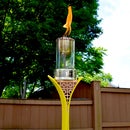Introduction: Make a Cat Litter Box That Doubles As a Bench
Despite the power of a cute kitten, when it comes to stinky litter, there’s no app for that.
And litter is a stinky mess.
Cat food and water spills from bowls. And there never seems to be a tidy way store cat essentials—everything from catnip and toys to food and litter. For houses that don’t have a room they can dedicate to pets, cat ownership becomes a constant contest with keeping this area clean and contained.
So we made a solution.
This clutter cutter is a fun project that creates a neat, easy-to-clean home for all your pet stuff. It doubles as a window seat for people and pets and fits nicely in any decor. And you can make it yourself. It’s a great weekend project.
With two levels and little cubbies front, left, and right for food and supplies, the Cat’s Cradle is a cool crash-pad.
And as much as cats’ super power of cute and cuddly can bestill the heart and raise the smile of any fan of furry affection like a Kryptonite against sadness and discomfort, some silver linings come with a little cloud. In this case, the cumulus is the litter box and associated paraphernalia.
So here’s how we made our Cat’s Cradle:
Step 1: Materials
We used PVC as our basic building material for the Cats’ Cradle. Fypon PVC is easy to work with, won’t absorb odors, messes and spills and looks great. Be careful, however, choosing PVC: they’re not all created equally. Some are very “plastic-y” and don’t come in a variety of sizes and profiles. And we used 3 sizes of material for this project, after looking through the options we had to choose from.
- (5) 1x6x12 tongue and groove bead board
- (3) 1x10x12
- (3) 1x4x12
- (1) Door pull
- (2) 30 inch piano hinges
- (1) pet door (optional)
- (1) tube construction adhesive
Step 2: Tools
Miter saw, table saw, and narrow crown stapler. We also used impact drivers and our countersink. We also used a big, flat work bench which we made ourselves from saw horses, 2x4s and a sheet of 3/4 inch birch plywood.
Step 3: How-To Tips
- Use an edge guide—some 1x2x36-inch fastened to the corner of your plywood worktable—as a square guide and stop. This is really handy for assembling the panels (walls) and installing the 1×2 ribs (cleats) on the back side.
> Use a narrow crown stapler for most of the fastening. Staples go in easily. They aren’t as likely to split material as nails can be for this kind of project where lots of fastening is done near the ends and edges. And, they cover nicely with putty.
> For seamless corners, miter the edges of the beadboard on the table saw. This means tipping the table saw blade to 45 degrees and running 8 pieces through, mitering what will be their outside corner. Tip: pre-assemble (dry-fit) a panel to see in real time which pieces are the corner pieces.
> For panel assembly (i.e. the front, back, left and right walls) we hold the tongue and groove beadboard together by fastening a 1-x2 cleat on the back side that we rip on the table saw. This can be a little tricky, but it is the key to the castle for pulling off this beadboard design. These cleats serve a second purpose as well: they support the interior floor, creating two levels. Here’s how to get all the pieces to fit together: For the front and back panels, the length of the cleat is measured from short-point-to-short-point of the panel’s miters. For the left and right panels, the cleat length is short-to-short on the miters—minus 1 1/2 inches. Instead of measuring this, however (it can be hard to see precisely) we use a simple gauge block, make our marks, and measure between the lines. Accurate and easy (or easier.)
> When installing the trim bands around the outside, measure carefully and double check that the box is still square as you install. This will make it easier to fit the lid inside later.
> If you have enough leftover scraps, make your own litter box. Having gone from a store-bought to a PVC box there is a world of difference in litter clean-up.
> The last step is to paint. While you don’t need to, adding a coat of semi- or high-gloss paint will keep the nooks and crannies brighter and easier to clean.
Step 4: Finally, Place in a Nice Spot.
We positioned ours under a window in our (ready to be remodeled) mud room and put a bright contrast-cushion on top. Now, we have a great place to sit or lay a jacket or scarf and the cat’s are cradled in comfort and have a room with a view.













